
South Korea's "first generation" of fully autonomous architects profiled in Rome exhibition
An office with a timber-lined courtyard and another with bold red trusses are among the projects to feature in an exhibition of contemporary South Korean architecture in Rome.
The Sections of Autonomy Six Korean Architects exhibition at Fondazione Pastificio Cerere focuses on six architecture studios that were founded in South Korea between the 1990s and early 2000s, and now form the "backbone" of Korean architecture.
The chosen era is marked by political and cultural freedom in the country, following Japanese colonial rule in the early 20th century that suppressed and discontinued the country's culture and traditions.
In 1967, pioneering Korean architect Kim Swoo-gen sought to find a cultural identity free from Japanese influence and traditional Korean style. But it was not until 30 years later that this was mastered.
Exhibition curators Choi Won-joon and Luca Galofaro have chosen six architects who set up their studios during this time to highlight examples of this autonomous style.
"It was Kim Swoo-geeun's will to practice in autonomy, free from heavy ideological burdens, but it would take another thirty years for Korean architecture to finally arrive at that autonomous state," said exhibition co-curator Choi Won-joon. "Now in their early to late fifties age-wise, they build up the backbone of Korean architecture."
"As the first generation of Korean architects who were finally free from pressures to modernise tradition, or to form groups for active social engagement," added Choi, "they were able to fully explore the multiple dimensions of architectural autonomy and their reasoned individuality, through a practice rooted in local culture and conditions, yet thoroughly contemporaneous with international currents."
The selected architects are Choi Moon-gyu of GaA Architects, Jang Yoon-gyoo from Unsangdong Architects, Kim Jong-kyu of MARU, Kim Jun-sung of Architecture Studio Hand, Kim Seung-hoy of KYWC Architects and Kim Young-joon of YO2 Architects also feature in the showcase.
Sections of Autonomy Six Korean Architects will be on show at the Fondazione Pastificio Cerere in Rome from 7 to 21 February 2017.
Read on for curator Choi Woon-joon's descriptions of projects by the six architects:
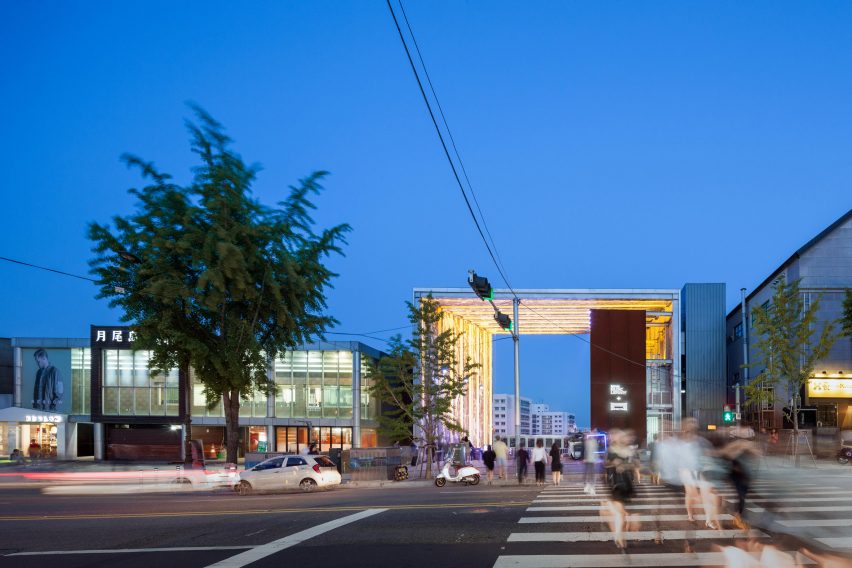
H Music Library, Seoul, 2015, by Choi Moon-gyu
What alternatives can architecture provide in an urban context of endless facades? While its underground levels are fully occupied by a concert hall, on the ground level, where the music library is located, the building becomes an urban interstice', open to changing view, atmosphere, and program all year long.
Sited on the main street of Itawwon-ro that slopes from Namsan Mountain to the Hangang River, it was natural, both functionally and spatially, to form a ramp than to use stairs. With no visual or spatial obstacles, the curved surface of the ground floor exists as one continuum, providing pedestrians with various outdoor experiences and a fantastic Gangnam view that is otherwise blocked by rows of roadside buildings.
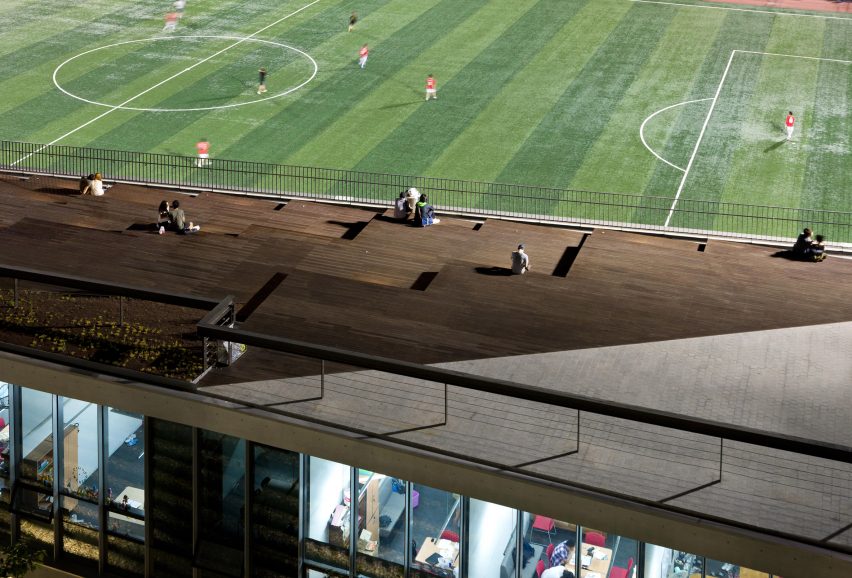
Soongsil University Student Union, Seoul, 2011, by Choi Moon-gyu
To minimise the impact on the adjacent square in the university's already dense campus, the new Student Union stretches out horizontally on the site. Utilising the site's 12 metre height difference to full advantage, almost half of the building is buried into the ground, suppressing the physical presence of a volume that contains 80 clubrooms, three cafeterias, a 200-seat theatre, administration offices, and stadium stands.
To allow natural ventilation and lighting, unique outdoor spaces are provided in three parts, one of which is the central stairway that functions as the building's spine, connecting the whole floors. With 25 entrances that lead visitors from every direction to a building with extensive relationship between outdoor and indoor spaces, the Student Union is a pathway itself, blurring the boundary between architecture and its surroundings.
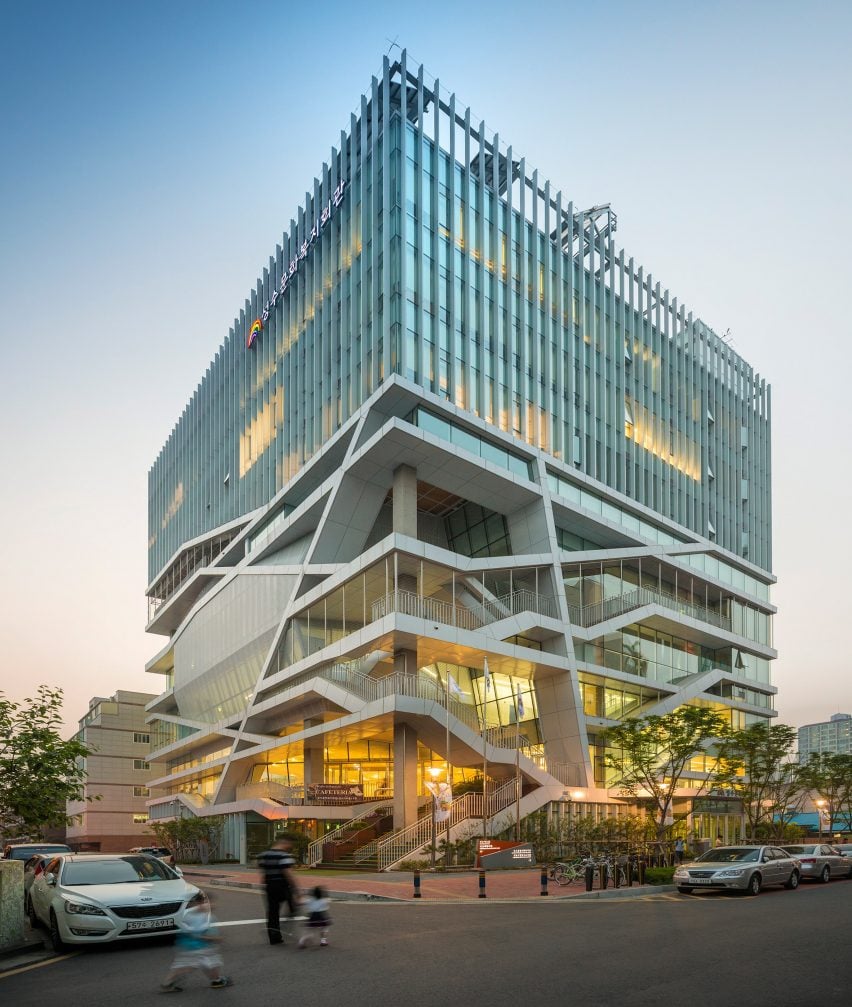
Seongdong Cultural & Welfare Center, Seoul, 2010, by Jang Yoon-gyoo
Located in the centre of a low-income factory district in Seongsudong, Seongdong Cultural & Welfare Center, or Culture Forest, is more than a government office building, which is usually distanced from the citizens. As an active agent of urban regeneration, it physically inserts itself to the decaying urban environment to provide new programmes of cultural, industrial, and economic rehabilitation that will initiate change in the surrounding city and community.
By accommodating the city's horizontal streets, plazas, and elements of nature, this urban structure constructs an open three-dimensional public space, animated by diverse culture- and welfare-related programmes and interests.
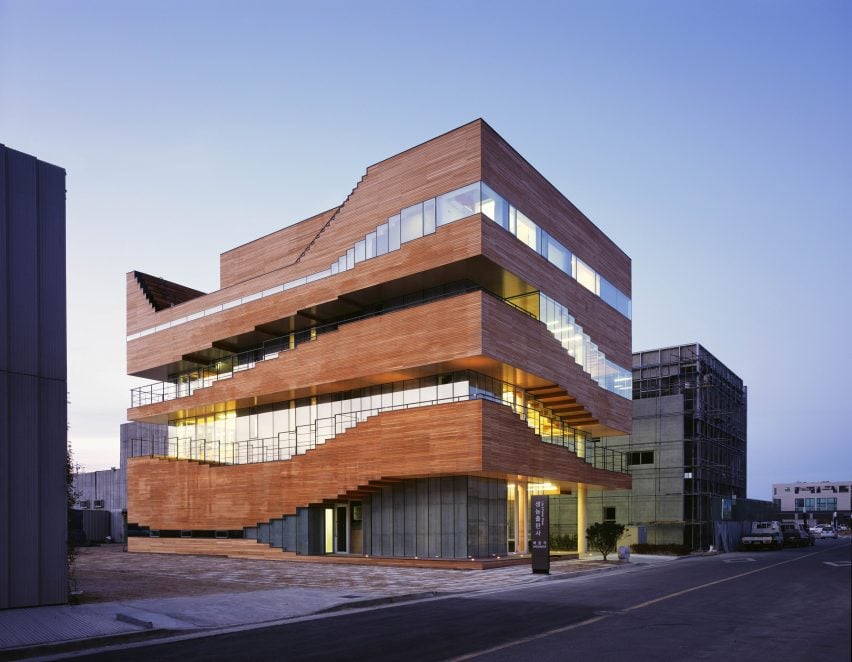
Kring / KumHo Culture Complex, Seoul, 2006, by Jang Yoon-gyoo
As modern society demands companies to seek their own brand codes, architecture too becomes part of this strategy of identity and differentiation. This project attempts to transfer such requirement into an opportunity to experiment with ways of complementary and reciprocal communication between customers and companies.
In this project, a new set of programme diagrams capture new programmes and spatial possibilities for office environments, which the corporate client can promote as a feature of its own cultural identity. It aims to establish a "branded space", the proposed complex is a passage for communication with customers, a place for holding public performances, exhibitions, and competitions, aided by the intervention of art coordinators
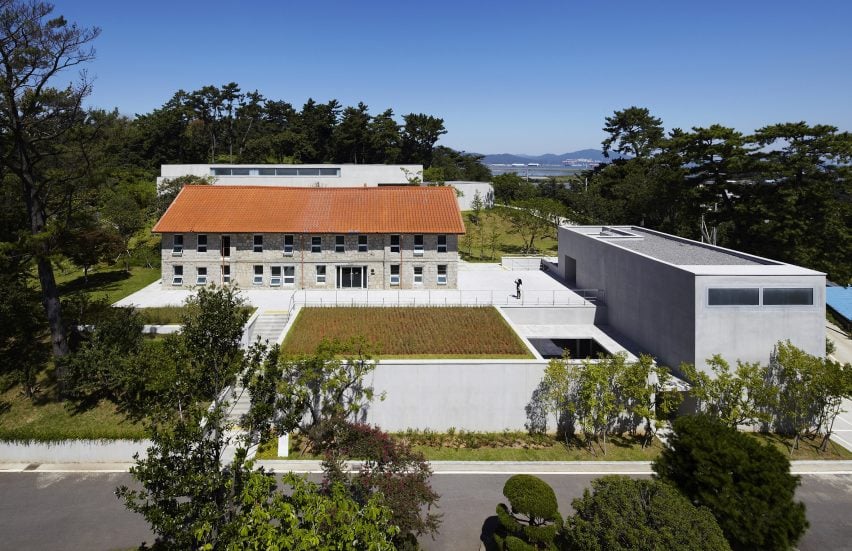
Hansen Museum, Yeosu, 2015, by Kim Jong-kyu
Eayangwon is a destination for missionaries and leprosy sufferers, who found refuge there in 1927. It now includes modern and contemporary buildings, and an extension to a small museum was required to cope with a larger collection.
The design began with the question of relating the site's small hill with the church and the museum, hundred-year-old registered cultural properties. The site already had a strong sense of place, and this addition was to carefully follow the existing conditions and look as if it had been there all along. In the exhibition building, the placement of layers between vertical and horizontal spaces provides a rhythmical and dramatic experience to its visitors.
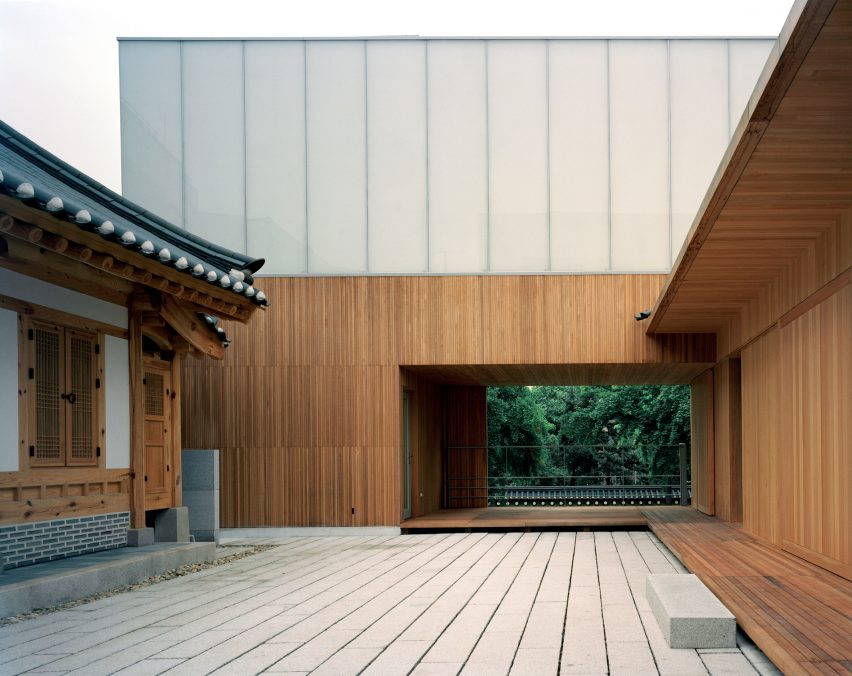
Arumjigi, Seoul, 2013, by Kim Jong-kyu
This head office for Arumjigi, a non-profit organisation for the protection and preservation of Korea's cultural heritage, is simple yet multifaceted: contrary to the generous and delicate appearance of the building facing the Hyoja-ro, the four story office finished with exposed concrete reticently faces the narrow and humble alley.
Since form is merely passive, relying on the volume and layout of its projected program, it is the material rather than the shape that is the distinguishing feature of Arumjigi at first glance. The essence of this building is the courtyard on the second floor, a space open to the sky and the wind, arranging a balanced harmony between the Hanok, a traditional house, and other buildings.
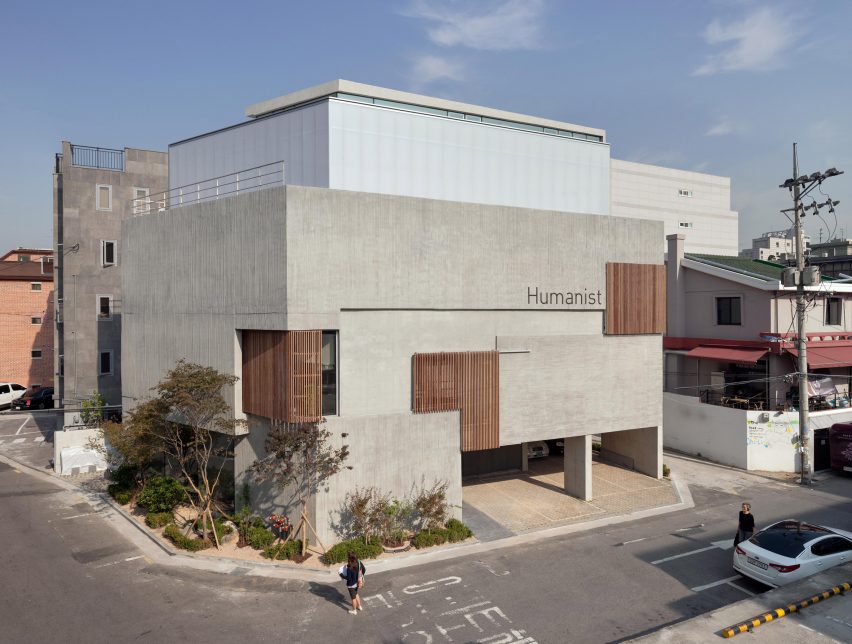
Humanist Books Office, Seoul, by Kim Jun-sung
The initiating goal of this office building for Humanist Publishing Co was not for functional efficiency but the creation of a place of communication with its neighbours. Only a few blocks away from the immensely popular Hongik University area, the site is located at the corner of a semi-residential area, and, with the size of 1,000-square-metres, is relatively tight.
However, even from the beginning, an outdoor open yard amidst an office environment was deemed essential for publishers whose work requires creativity and high concentration. This inner open yard runs through the whole body of office building, like a street stretching down to the underground auditorium and upwards to the top office floor, and its depth is reinforced by its glass facades with different inclinations.
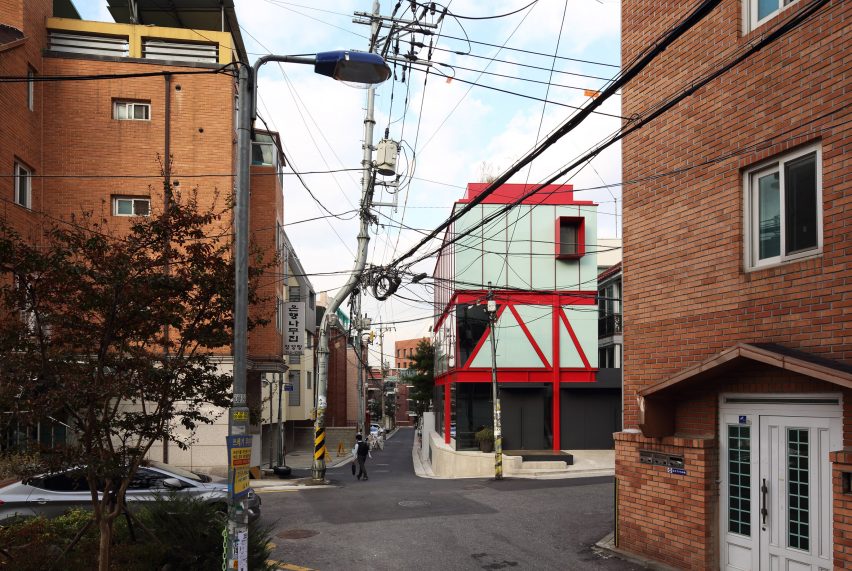
KYWC Architects office, Soyul, Seoul, Kim Seung-hoy
KYWC Architects' own office building is situated at the foot of Namsan Mountain in the old alleys of Huam-dong. To fit the three above-ground floors within the height limit of 8.7 metres, the whole second floor was formed as a truss, minimising structure members of other floors. Coloured in red, the structural frames express the linear flow of force, while their flushed infill of spandrel glasses create a deceptively simple volume, within which all levels, from basement to roof garden, maintain their own spatial characteristics, corresponding to different programs, structures, and urban conditions.
The ground floor, for instance, a space for social gathering, is open to the city with minimum structure elements, reflecting the aims of this 'micro-cosmos' to integrate construction, program, and urban relationships into a singular system.
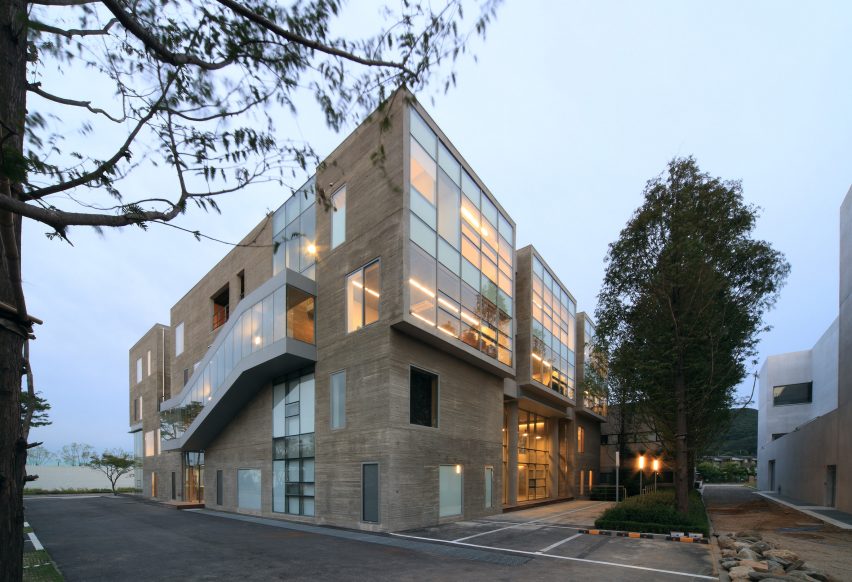
Hakhyunsa Publishing Co, Paju, 2008, by Kim Young-joon
This project, initiated at the end of the first stage of Paju Book City, was an extension of the long-term investigation on architecture with organisation of a city. From the premises concerning multiple approaches and flexible outcomes, to the relative positioning between the artificial and the natural, and the filled and the void, these factors were to be translated into architecture via a collective system, and such organisation was eventually made possible via a system of three compartmentalised groups in plans and sections.
The architectural solution to uncertain conditions was to create a connection of individual double-floor units. Avoiding a collective form of repeating unit-spaces, a collective system is attuned towards stacked-density, variety of spatial scales, and independence of interconnections.